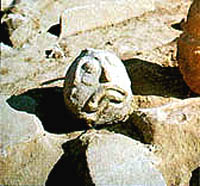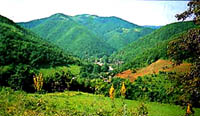|
DJERDAP NATIONAL PARK
 The Djerdap National Park stretches along the right bank of the Danube River
from Golubacki grad to the dam near Sip. It spreads on 64,000 hectares and
the park management office is in Donji Milanovac on the Danube.
The Djerdap National Park stretches along the right bank of the Danube River
from Golubacki grad to the dam near Sip. It spreads on 64,000 hectares and
the park management office is in Donji Milanovac on the Danube.
The main feature and attraction of the Djerdap National Park's natural
beauty is the Djerdap gorge - the famous Iron Gate - the grandiose gateway
through the southern slopes of the Carpathian mountains where the longest
and biggest river accumulation in Yugoslavia is located.
The Djerdap gorge, which is some 100 kilometers long (from Golubac to
Tekija), is actually a compound river valley made up of four gorges (Gornja
klisura, Gospodjin vir, Veliki and Mali kazan and Sipska klisura), separated
from each other by ravines. In Gospodjin vir, one of the greatest river
depths in the world has been measured (82 m). The cliffs of the canyon in
Kazan are about 300 meters high while the riverbed in this part is narrowed
down to 150 meters.
 The territory of the national park is filled with a series of other
important features: abundant and diversified animal and especially plant
life, attractive surroundings and landscapes, cultural and historical
monuments and other anthropogenic tourist attractions, including a lake
formed by the erection of a hydroelectric power plant.
The territory of the national park is filled with a series of other
important features: abundant and diversified animal and especially plant
life, attractive surroundings and landscapes, cultural and historical
monuments and other anthropogenic tourist attractions, including a lake
formed by the erection of a hydroelectric power plant.
The national park is dotted with many natural and cultural values which
are included in a special protection programme: Lepenski Vir, the
8,000-year-old archaeological site with exceptionally important traces of
settlements and the life of neolithic man, the Golubacki Grad fortress, the
fortress in Kladovo, forest reserves and natural monuments.
The Djerdap National Park has become one of the most visited tourist
regions in Serbia especially after the construction of the dam and the
formation
of the large lake. The gorge and the hydroelectric power plant can be
visited
from Belgrade and other cities downtream from it. There are a number of
tourist points in the park with hotel and other facilities, offering
tourists
rest and swimming and tours of the cultural and historical monuments and
natural values. |



